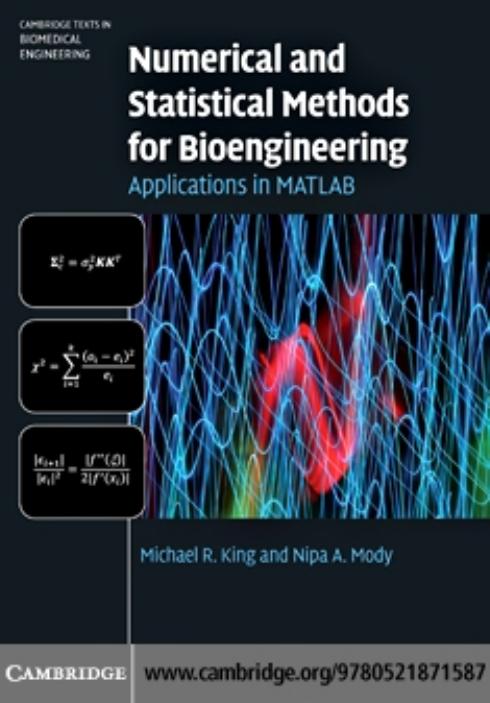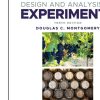Numerical and Statistical Methods for Bioengineering 1st edition by Michael King, Nipa Mody ISBN 1107486688 9781107486683
$70.00 Original price was: $70.00.$35.00Current price is: $35.00.
Instant download Numerical and Statistical Methods for Bioengineering after payment
Numerical and Statistical Methods for Bioengineering 1st edition by Michael King, Nipa Mody – Ebook PDF Instant Download/Delivery: 1107486688, 9781107486683
Full download Numerical and Statistical Methods for Bioengineering 1st edition after payment

Product details:
ISBN 10: 1107486688
ISBN 13: 9781107486683
Author: Michael King, Nipa Mody
The first MATLAB-based numerical methods textbook for bioengineers that uniquely integrates modelling concepts with statistical analysis, while maintaining a focus on enabling the user to report the error or uncertainty in their result. Between traditional numerical method topics of linear modelling concepts, nonlinear root finding, and numerical integration, chapters on hypothesis testing, data regression and probability are interweaved. A unique feature of the book is the inclusion of examples from clinical trials and bioinformatics, which are not found in other numerical methods textbooks for engineers. With a wealth of biomedical engineering examples, case studies on topical biomedical research, and the inclusion of end of chapter problems, this is a perfect core text for a one-semester undergraduate course.
Numerical and Statistical Methods for Bioengineering 1st Table of contents:
PART I: NUMERICAL ERROR AND METHODS
CHAPTER 1: TYPES AND SOURCES OF NUMERICAL ERROR
- 1.1 Introduction
- 1.2 Representation of Floating-Point Numbers
- 1.2.1 How Computers Store Numbers
- 1.2.2 Binary to Decimal System
- 1.2.3 Decimal to Binary System
- 1.2.4 Binary Representation of Floating-Point Numbers
- 1.3 Methods Used to Measure Error
- 1.4 Significant Digits
- 1.5 Round-Off Errors Generated by Floating-Point Operations
- 1.6 Taylor Series and Truncation Error
- 1.6.1 Order of Magnitude Estimation of Truncation Error
- 1.6.2 Convergence of a Series
- 1.6.3 Finite Difference Formulas for Numerical Differentiation
- 1.7 Criteria for Convergence
- 1.8 End of Chapter 1: Key Points to Consider
- 1.9 Problems
- References
PART II: SYSTEMS OF LINEAR EQUATIONS
CHAPTER 2: SYSTEMS OF LINEAR EQUATIONS
- 2.1 Introduction
- 2.2 Fundamentals of Linear Algebra
- 2.2.1 Vectors and Matrices
- 2.2.2 Matrix Operations
- 2.2.3 Vector and Matrix Norms
- 2.2.4 Linear Combinations of Vectors
- 2.2.5 Vector Spaces and Basis Vectors
- 2.2.6 Rank, Determinant, and Inverse of Matrices
- 2.3 Matrix Representation of a System of Linear Equations
- 2.4 Gaussian Elimination with Backward Substitution
- 2.4.1 Gaussian Elimination without Pivoting
- 2.4.2 Gaussian Elimination with Pivoting
- 2.5 LU Factorization
- 2.5.1 LU Factorization without Pivoting
- 2.5.2 LU Factorization with Pivoting
- 2.5.3 The MATLAB
luFunction
- 2.6 The MATLAB Backslash (
) Operator - 2.7 Ill-Conditioned Problems and the Condition Number
- 2.8 Linear Regression
- 2.9 Curve Fitting Using Linear Least-Squares Approximation
- 2.9.1 The Normal Equations
- 2.9.2 Coefficient of Determination and Quality of Fit
- 2.10 Linear Least-Squares Approximation of Transformed Equations
- 2.11 Multivariable Linear Least-Squares Regression
- 2.12 The MATLAB Function
polyfit - 2.13 End of Chapter 2: Key Points to Consider
- 2.14 Problems
- References
PART III: PROBABILITY AND STATISTICS
CHAPTER 3: PROBABILITY AND STATISTICS
- 3.1 Introduction
- 3.2 Characterizing a Population: Descriptive Statistics
- 3.2.1 Measures of Central Tendency
- 3.2.2 Measures of Dispersion
- 3.3 Concepts from Probability
- 3.3.1 Random Sampling and Probability
- 3.3.2 Combinatorics: Permutations and Combinations
- 3.4 Discrete Probability Distributions
- 3.4.1 Binomial Distribution
- 3.4.2 Poisson Distribution
- 3.5 Normal Distribution
- 3.5.1 Continuous Probability Distributions
- 3.5.2 Normal Probability Density
- 3.5.3 Expectations of Sample-Derived Statistics
- 3.5.4 Standard Normal Distribution and the Z Statistic
- 3.5.5 Confidence Intervals Using the Z Statistic and the T Statistic
- 3.5.6 Non-Normal Samples and the Central-Limit Theorem
- 3.6 Propagation of Error
- 3.6.1 Addition/Subtraction of Random Variables
- 3.6.2 Multiplication/Division of Random Variables
- 3.6.3 General Functional Relationship Between Two Random Variables
- 3.7 Linear Regression Error
- 3.7.1 Error in Model Parameters
- 3.7.2 Error in Model Predictions
- 3.8 End of Chapter 3: Key Points to Consider
- 3.9 Problems
- References
PART IV: HYPOTHESIS TESTING
CHAPTER 4: HYPOTHESIS TESTING
- 4.1 Introduction
- 4.2 Formulating a Hypothesis
- 4.2.1 Designing a Scientific Study
- 4.2.2 Null and Alternate Hypotheses
- 4.3 Testing a Hypothesis
- 4.3.1 The P-Value and Assessing Statistical Significance
- 4.3.2 Type I and Type II Errors
- 4.3.3 Types of Variables
- 4.3.4 Choosing a Hypothesis Test
- 4.4 Parametric Tests and Assessing Normality
- 4.5 The Z-Test
- 4.5.1 One-Sample Z-Test
- 4.5.2 Two-Sample Z-Test
- 4.6 The T-Test
- 4.6.1 One-Sample and Paired Sample T-Tests
- 4.6.2 Independent Two-Sample T-Test
- 4.7 Hypothesis Testing for Population Proportions
- 4.7.1 Hypothesis Testing for a Single Population Proportion
- 4.7.2 Hypothesis Testing for Two Population Proportions
- 4.8 One-Way ANOVA
- 4.9 Chi-Square Tests for Nominal Scale Data
- 4.9.1 Goodness-of-Fit Test
- 4.9.2 Test of Independence
- 4.9.3 Test of Homogeneity
- 4.10 More on Non-Parametric (Distribution-Free) Tests
- 4.10.1 Sign Test
- 4.10.2 Wilcoxon Signed-Rank Test
- 4.10.3 Wilcoxon Rank-Sum Test
- 4.11 End of Chapter 4: Key Points to Consider
- 4.12 Problems
- References
PART V: ROOT-FINDING TECHNIQUES FOR NONLINEAR EQUATIONS
CHAPTER 5: ROOT-FINDING TECHNIQUES FOR NONLINEAR EQUATIONS
- 5.1 Introduction
- 5.2 Bisection Method
- 5.3 Regula-Falsi Method
- 5.4 Fixed-Point Iteration
- 5.5 Newton’s Method
- 5.5.1 Convergence Issues
- 5.6 Secant Method
- 5.7 Solving Systems of Nonlinear Equations
- 5.8 MATLAB Function
fzero - 5.9 End of Chapter 5: Key Points to Consider
- 5.10 Problems
- References
PART VI: NUMERICAL QUADRATURE
CHAPTER 6: NUMERICAL QUADRATURE
- 6.1 Introduction
- 6.2 Polynomial Interpolation
- 6.3 Newton–Cotes Formulas
- 6.3.1 Trapezoidal Rule
- 6.3.2 Simpson’s 1/3 Rule
- 6.3.3 Simpson’s 3/8 Rule
- 6.4 Richardson’s Extrapolation and Romberg Integration
- 6.5 Gaussian Quadrature
- 6.6 End of Chapter 6: Key Points to Consider
- 6.7 Problems
- References
PART VII: NUMERICAL INTEGRATION OF ORDINARY DIFFERENTIAL EQUATIONS
CHAPTER 7: NUMERICAL INTEGRATION OF ORDINARY DIFFERENTIAL EQUATIONS
- 7.1 Introduction
- 7.2 Euler’s Methods
- 7.2.1 Euler’s Forward Method
- 7.2.2 Euler’s Backward Method
- 7.2.3 Modified Euler’s Method
- 7.3 Runge–Kutta (RK) Methods
- 7.3.1 Second-Order RK Methods
- 7.3.2 Fourth-Order RK Methods
- 7.4 Adaptive Step Size Methods
- 7.5 Multistep ODE Solvers
- 7.5.1 Adams Methods
- 7.5.2 Predictor–Corrector Methods
- 7.6 Stability and Stiff Equations
- 7.7 Shooting Method for Boundary-Value Problems
- 7.7.1 Linear ODEs
- 7.7.2 Nonlinear ODEs
- 7.8 End of Chapter 7: Key Points to Consider
- 7.9 Problems
- References
PART VIII: NONLINEAR MODEL REGRESSION AND OPTIMIZATION
CHAPTER 8: NONLINEAR MODEL REGRESSION AND OPTIMIZATION
- 8.1 Introduction
- 8.2 Unconstrained Single-Variable Optimization
- 8.2.1 Newton’s Method
- 8.2.2 Successive Parabolic Interpolation
- 8.2.3 Golden Section Search Method
- 8.3 Unconstrained Multivariable Optimization
- 8.3.1 Steepest Descent or Gradient Method
- 8.3.2 Multidimensional Newton’s Method
- 8.3.3 Simplex Method
- 8.4 Constrained Nonlinear Optimization
- 8.5 Nonlinear Error Analysis
- 8.6 End of Chapter 8: Key Points to Consider
- 8.7 Problems
- References
PART IX: BASIC ALGORITHMS OF BIOINFORMATICS
CHAPTER 9: BASIC ALGORITHMS OF BIOINFORMATICS
- 9.1 Introduction
- 9.2 Sequence Alignment and Database Searches
- 9.3 Phylogenetic Trees Using Distance-Based Methods
- 9.4 End of Chapter 9: Key Points to Consider
- 9.5 Problems
- References
APPENDICES
Appendix A: Introduction to MATLAB
Appendix B: Location of Nodes for Gauss–Legendre Quadrature
Index for MATLAB Commands
Index
People also search for Numerical and Statistical Methods for Bioengineering 1st:
numerical and statistical methods for bioengineering applications in matlab
numerical and statistical methods for bioengineering pdf
numerical and statistical methods for bioengineering applications in matlab pdf
numerical statistical methods
numerical methods in biomedical engineering
Tags:
Michael King,Nipa Mody,Statistical Methods,Bioengineering


